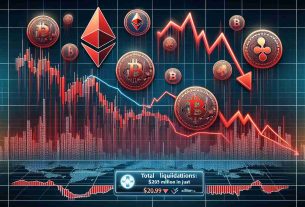XRP witnesses a dramatic price spike, according to reports from cryptocurrency enthusiasts observing the data from TradingView. The platform inexplicably exhibited XRP’s price as a staggering $9,864, triggering discussions and excitement within the XRP community.
The glitch caught the community by storm, especially when juxtaposed with XRP’s modest price of $0.22 at the time. Such glitches have a magnetic effect within the community, despite being widely regarded as simple system errors not indicative of actual market value.
XRP’s sudden surge in value was put under the spotlight by community influencer Jack The Rippler, who deemed the moment as one of the most significant price anomalies for the cryptocurrency. Jack The Rippler’s enthusiasm fueled speculation about hidden values of XRP, which others in the community playfully conjectured as its clandestine price tag.
Despite attention from ardent followers, a majority recognize these spikes as entertaining rather than evidence of any behind-the-scenes valuation of XRP. One individual, an Air Force Veteran with close ties to the community, clarified that these prices are not taken seriously by investors.
Not the first instance of a pricing mishap, XRP has faced similar glitches in the past. A notable incident in 2020 had been thoroughly investigated, confirming that it was merely a system error on May 7, 2020. Such events have recurred over the years, including one that listed XRP at $70 on the Atlantis Exchange due to diminished trading volume and another with a price leap to $34,603 on CoinMarketCap.
It is clear that anomalies in XRP’s price have served to amuse and capture the imaginations of cryptocurrency enthusiasts. Despite this, all market participants are advised to conduct diligent research before making investment decisions.
XRP Community Responds to Astonishing TradingView Glitch
In the world of cryptocurrencies, where volatility is a given and prices can fluctuate wildly, a remarkable incident occurred when TradingView, one of the foremost charting platforms for traders and investors, displayed an unrealistic price spike for XRP. The sudden, pseudo-increase in XRP’s price to $9,864 was not a true reflection of its market value, deeply contrasting with the actual prevailing price of around $0.22.
Community Reaction and Historical Glitches
The significant discrepancy caused by the glitch sparked enthusiasm among the XRP community, leading to discussions and theories about the potential and value of XRP. It is important to note that these events are not uncommon. In the past, other cryptocurrencies have also experienced similar erroneous price displays due to technical errors. Such discrepancies are typically quickly resolved without real impact on trading.
Investment Decisions and Market Vigilance
For investors and traders, this glitch serves as an important reminder to rely on multiple reputable sources when making investment decisions. Utilizing one data point or price source could lead to critical misjudgments, especially in the cryptocurrency market where pricing is highly sensitive and can be influenced by numerous factors, such as market liquidity, sentiments, and technological issues.
Considering the Role of Exchanges and Data Accuracy
A key challenge that arises from such situations is the reliability of exchange data and the various platforms that aggregate this data. This underscores the importance for exchanges and financial services to employ robust technological infrastructures capable of mitigating such glitches to maintain the integrity of the data provided to users.
Advantages and Disadvantages
The advantages of this event tend to be more ethereal, catering to the sense of community and discussion among crypto enthusiasts. It can also highlight the importance of solid technology and data reliability in fintech platforms.
The disadvantages, however, can have a real impact, particularly if traders act on incorrect information, potentially leading to significant financial losses. Furthermore, frequent glitches can diminish trust in platforms and services, possibly leading to a migration of users to competitors with perceived higher reliability.
For reliable sources on cryptocurrency data and to avoid misinformation, it would be prudent to refer to the major website domains of established platforms in the industry. Make sure to always verify the information by visiting the official websites such as CoinMarketCap or CoinGecko. Only do so with URLs that are certain to be correct and that do not lead to subpages, to ensure you obtain accurate and legitimate data.



